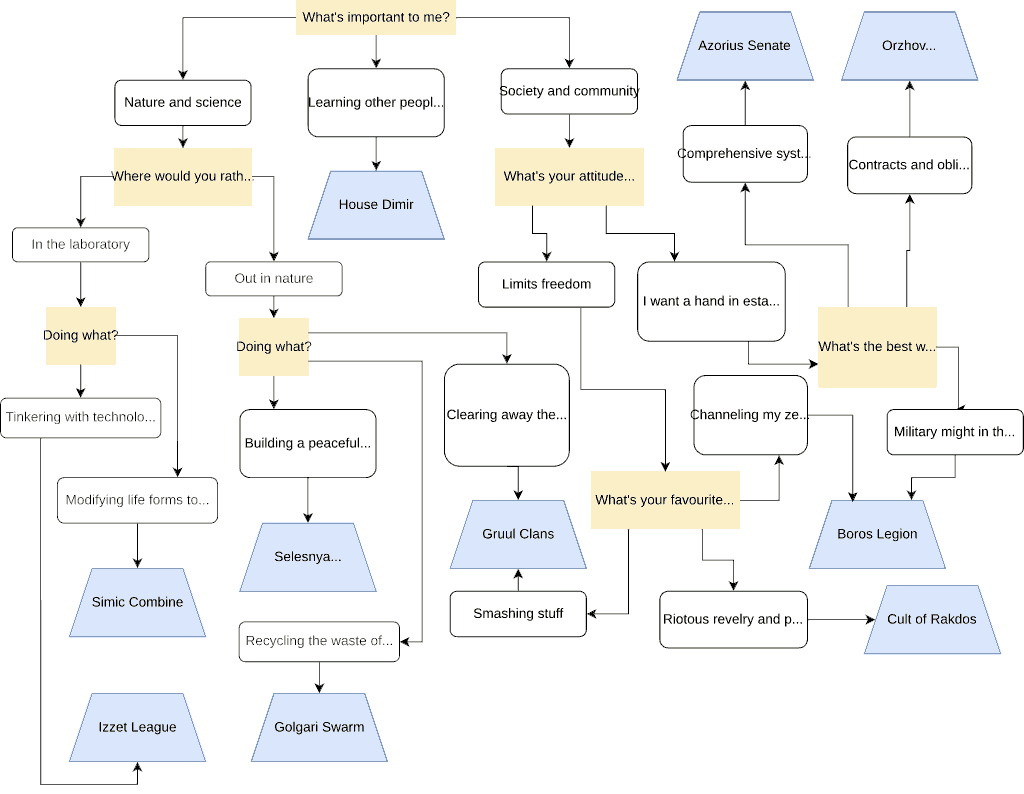In a previous post, I explained why I love alignment in D&D, but I acknowledged that it doesn't have to work for everyone. I also admitted that I'd recently discovered an alternative to the system, but I didn't say where I'd found it.
When I bought the book Guildmasters' Guide to Ravnica, I wasn't looking for a replacement for alignment. I was excited about the book, because it was the first official official Magic the Gathering D&D cross-over, and it was a cross-over I'd been waiting on ever since I saw my first Tony DiTerlizzi card. Ravnica seemed like a great, if not surprising, place to start, so I bought the book and read it cover to cover.
The book spends a lot of time getting players assigned to the ten guilds of Ravnica. Like, a really long time. Out of 256 pages, 98 of them are spent on the guilds. Having read the Ravnica stories that Wizards of the Coast published as part of the Magic the Gathering storyline, I think this book qualifies as the most comprehensive information about the guilds we have. The Magic cards from Ravnica provide some flavour text that hints at the nature of each guild, and the way the cards themselves play betray a lot about each guild. This book, however, codifies it. It's almost revelatory, the same way the Monster Manual was back when I first encountered it in grade school. It satiates that geek compulsion to classify, correlate, diff, and cross-reference data. Sure I always knew that Azorius and Rakdos were fundamentally at odds, or that Golgari and Selesnya maybe were more alike than either wanted to admit, but now I could see it for myself, laid out in plain English and classic D&D tables.
The more I read through the descriptions of Guilds and the mechanics developed around them, the more I realized that the Guilds didn't just represent occupation and allegiance on Ravnica, they formed a system of ethics. Were you a citizen of Ravnica, you would structure your behaviour in accordance with your Guild. There are no gods of Ravnica, aside from the Nephilim, but they were old and forgotten. It's the Guilds that form the moral foundation of life on Ravnica.
The morality of Guilds
The Guilds don't map exactly to D&D alignment, and that's good. The alignment system is a lot more flexible than, say, modern Judeo-Christian morality, which is essentially binary: you're either Saved or you're Damned.
Traditional D&D alignment essentially sets up new binary pairs, allowing you to be Good or Evil according to a certain behaviour pattern (Lawful, Neutral, or Chaotic). To allow for those who want to abstain from the debate altogether, there's also a Neutral option. There's lots of room for interpretation in each sector of alignment (as there is in real life morality), but there are Gods and extra-planar Powers who sort out the details.
In Ravnica, the founding principles of the guilds are the five colours of Magic, each of which has a whole variety of characteristics. But each guild each uses two colours, so there's a lot of variety in traits that each guild can embody. Instead of a the toggle switch of modern Christian morality, and instead of the matrix of traditional D&D alignment, Ravnican guilds offer, well, a whole flowchart. Literally. It's in the book.

Guildmasters' Guide takes the natural inclinations of the Guilds and adds the Renown mechanic. Renown is basically a reward system for acting in the interest of your guild, or in other words, for following the ethics of your chosen path. It's a morality system. You make good decisions, you rake in rewards.
The rewards are tangible, too. As you gain renown within your guild, you get resources you to use in your adventures. Eventually, you climb in ranking within your guild, earning recognition from even your guild leaders.
To me, at least, this all seems pretty familiar, because it's almost exactly how I reward players for following their alignment. They get gifts from the people they help, they gain powers or magical weapons, and finally they warrant the attention of a god.
(You might think that Ravnican Guilds seem similar to, for instance, factions in Pathfinder or D&D Adventure League. At first glance, they are, but all the factions I've used in the past are usually pretty single-minded. If anything, the Guilds make me think of Planescape, but because alignment was present in Planescape I always felt that they played into alignment more than they superseded it.)
Swap it
I've run games in Ravnica, and they're the only D&D games I've ever run that didn't involve choosing alignment. Much to my surprise, that didn't affect the way I ran the game. Utilizing the guilds was a natural and perfectly suitable alternative.
Possibly Ravnica's Guilds, aside from being specific in flavour, aren't broad enough for general use. But I could see similar definitions for other settings working just as well.